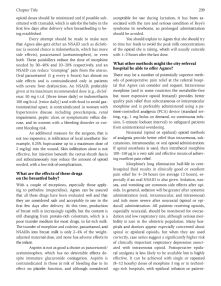Page 251 Guide to Pain Management in Low-Resource Settings
P. 251
Chapter Title 239
opioid doses should be minimized and if possible sub- acceptable for use during lactation, it has been as-
stituted with tramadol, which is safe for the baby in the sociated with the rare and serious condition of Reye’s
fi rst few days after delivery when breastfeeding is be- syndrome in newborns, so prolonged administration
ing established. should be avoided.
Every attempt should be made to make sure You should explain to Agnes that she should try
that Agnes also gets either an NSAID such as diclofe- to time her feeds to avoid the peak milk concentrations
nac (a second choice is indomethacin, which has more of the opioid she is taking, which will usually coincide
side eff ects), paracetamol (acetaminophen), or even with 1–2 hours after the last dose.
both. Th ese painkillers reduce the dose of morphine
What other methods might the city referral
needed by 30–40% and 10–20% respectively, and an
hospital be able to off er Agnes?
NSAID can reduce “cramping” pain from the uterus.
Oral paracetamol (1 g every 6 hours) has almost no Th ere may be a number of potentially superior meth-
side eff ects and is contraindicated only in patients ods of postoperative pain relief at the referral hospi-
with severe liver dysfunction. An NSAID, preferably tal that Agnes can consider and request. Intravenous
given at its maximum recommended dose (e.g., diclof- morphine (and in some countries the metabolite-free
enac 50 mg t.i.d. [three times daily] or indomethacin but more expensive opioid fentanyl) provides better
100 mg b.i.d. [twice daily]) and with food to avoid gas- quality pain relief than subcutaneous or intramuscular
trointestinal upset, is contraindicated in women with morphine and is preferably administered using a pa-
hypertensive disease including preeclampsia, renal tient-controlled analgesia (PCA) device (standard set-
impairment, peptic ulcer, or symptomatic refl ux dis- ting, e.g., 1 mg bolus on demand, no continuous infu-
ease, and in women with a bleeding disorder or cur- sion, 5-minute lockout interval) to safeguard patients
rent bleeding risk. from unintentional overdosing.
An additional measure for the surgeon, that is Neuraxial (spinal or epidural) opioid methods
not too expensive, is infi ltration of local anesthetic (for of analgesia provide better relief than intravenous, sub-
example, 0.25% bupivacaine up to a maximum dose of cutaneous, intramuscular, or oral opioid administration.
2 mg/kg) into the wound. Skin infi ltration alone is not If spinal anesthesia is used, then intrathecal morphine
eff ective, but injection beneath the rectus sheath fascia 100–150 μg is a very safe and eff ective means of achiev-
and subcutaneously may reduce the amount of opioid ing excellent pain relief.
needed, with a low risk of complications. Morphine’s long elimination half-life in cere-
brospinal fl uid results in clinically good or excellent
What are the eff ects of these drugs pain relief for 4–24 hours (on average 12 hours), es-
on the breastfed baby? pecially if an oral NSAID is also given. Sedation, nau-
With a couple of exceptions, especially those apply- sea, and vomiting are common side eff ects after opi-
ing to pethidine (meperidine), Agnes can be assured oids. In general, sedation will be greater after systemic
that all these drugs have been evaluated well and that administration (oral, intramuscular, and intravenous)
they are considered safe and acceptable to use in the and itch more severe after neuraxial (spinal or epi-
fi rst few days after delivery. At this time, production dural) administration. All patients receiving opioids,
of breast milk is increasingly rapidly, but the content is especially neuraxial, should be monitored for overse-
still changing from protein-rich colostrum, which is a dation and low respiratory rate, although serious mor-
poor transfer medium for most drugs, to fat-rich milk. bidity is rare in the obstetric population. Many hos-
Th e transfer of morphine and codeine, paracetamol, and pitals and doctors appear especially concerned about
NSAIDs into breast milk is only 2–4% of the weight- spinal or epidural opioids, but when they are used
adjusted maternal dose, and none has adverse eff ects in correctly, case series suggest a signifi cantly higher risk
the infant. of clinically important respiratory depression associ-
Aspirin is not as good a choice as paracetamol/ ated with intravenous opioid. Postoperative epidu-
acetaminophen, which has no detectable eff ects de- ral analgesia is less likely to be available but is highly
spite immature glucuronide conjugation. Aspirin is eff ective. It can be achieved with single or repeated
contraindicated in those at risk of bleeding due to its (8–12 hourly) doses of morphine 3 mg or in technol-
eff ect on platelet function, and although considered ogy-rich hospitals, with epidural infusion or patient-


